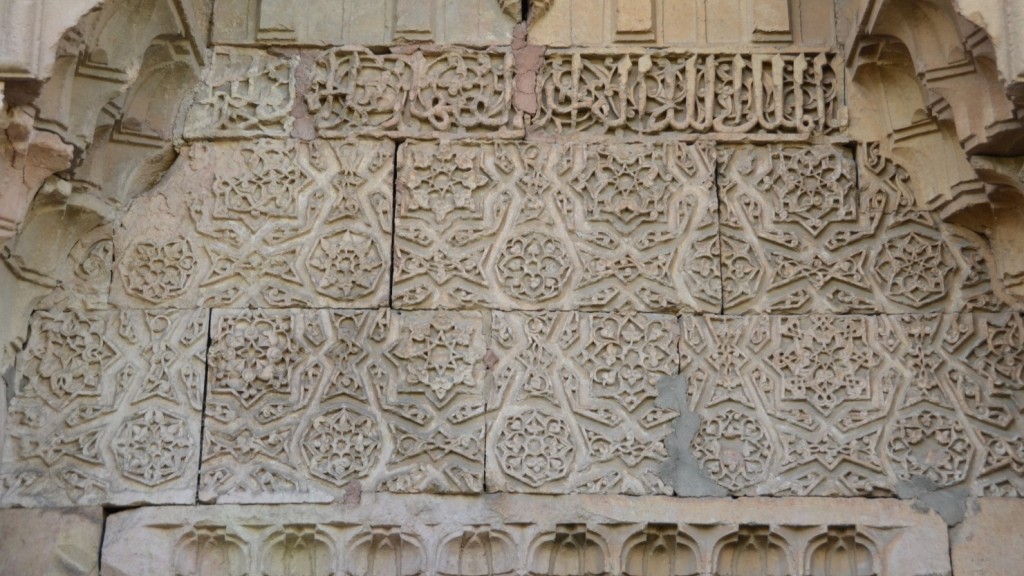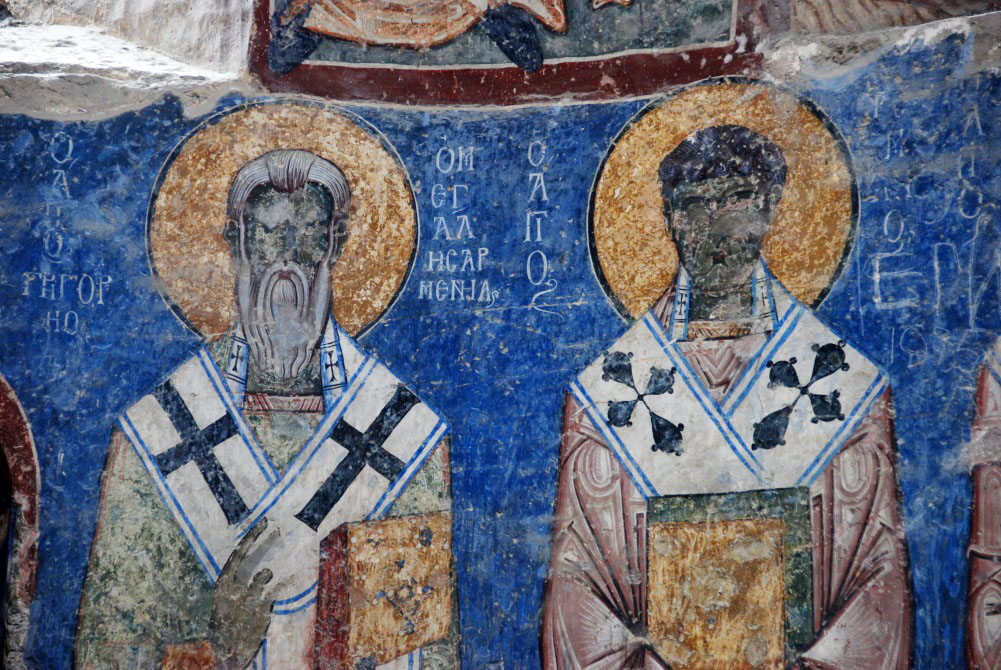
In the twelfth to fourteenth centuries four worlds met in the region of eastern Anatolia and the Caucasus: the Christian cultures of Anatolia (including Byzantines and Syriacs) and the Caucasus (principally the Georgians and Armenians, each allied to different Christian confessions), the Turkic cultures of Anatolia (the Seljuk Turks and other Turkoman groups), the Arabic culture of Syria that reached into northern Mesopotamia, and the Persian culture of Iranian Azerbaijan. The invasions of the Khwarazmians and then the Mongols in the 1230s and 1240s added yet more distinct ethnic, religious and cultural groups. All these societies were culturally vibrant and produced high quality works of art in the region, principally architecture, but also precious arts (ceramics, metalwork, manuscripts, etc.). These works of art are now divided by modern frontiers (Georgia, Armenia, Turkey, Azerbaijan, Iran), but the medieval cultures were not themselves discrete, isolated entities, rather they were overlapping and interdependent. This seminar seeks to reunite the study of these monuments, to examine cross-cultural interaction across the region.
 The constant shifting of political and cultural frontiers in the Middle Ages meant that populations became interlaced and artists might work for very different patrons. Each new war and conquest overlaid an additional culture on already complex and intertwined societies. There is a wealth of material evidence through which to explore the networks of relationships that resulted: primarily buildings (mosques, madrasas, monasteries and churches; caravanserais, hospitals, bridges; palaces, city walls), but also ceramics, metalwork and manuscripts. Frequently Christian populations were allowed to maintain their worship under Muslim rule, and vice versa. Shared shrines and common popular beliefs (e.g. in astrology and apotropaic imagery), and trans-regional trade routes all facilitated the development of common visual languages. The surviving network of caravanserais that connect Anatolia to Armenia, Syria and Iran are testimony to the importance of travel and movement across the region in this period.
The constant shifting of political and cultural frontiers in the Middle Ages meant that populations became interlaced and artists might work for very different patrons. Each new war and conquest overlaid an additional culture on already complex and intertwined societies. There is a wealth of material evidence through which to explore the networks of relationships that resulted: primarily buildings (mosques, madrasas, monasteries and churches; caravanserais, hospitals, bridges; palaces, city walls), but also ceramics, metalwork and manuscripts. Frequently Christian populations were allowed to maintain their worship under Muslim rule, and vice versa. Shared shrines and common popular beliefs (e.g. in astrology and apotropaic imagery), and trans-regional trade routes all facilitated the development of common visual languages. The surviving network of caravanserais that connect Anatolia to Armenia, Syria and Iran are testimony to the importance of travel and movement across the region in this period.
Aims
- The fundamental aim of this seminar is to study the interaction of all the cultures in the region through their principal surviving remains: the buildings and art works that they commissioned.
- We aim to show that monuments can participate simultaneously in multiple art histories across the region, and that the understanding of individual monuments benefits from studying them from multiple viewpoints. This is a pluralistic approach to the study of each monument and of the region as a whole.
- We will map the ways in which architectural forms were employed across the region, to think more about networks of buildings across modern frontiers and across medieval religious and cultural boundaries. When set in the context of a number of different, parallel cultural traditions, each monument emerges as a richer source of information about how the societies of Anatolia and the Caucasus interacted.
- When in front of the monuments we will consider the function and uses of the shared visual languages that emerged: do they reflect shared beliefs and practices, or do they deliberately disguise differences? We will take account of interaction and similarities as much as any hostility and difference.
- We seek to encourage debate as to how we can develop a truly interdisciplinary examination of the artistic and cultural history of this region during this period of enormous change, but also of great vitality and innovation.
 Each research trip lasts nine or ten days. The format of each trip follows a standard pattern, combining visits to monuments where project members present the material and short sessions at the hotel at which participants draw on their own research interests and discuss the larger thematic strands identified by the group.
Each research trip lasts nine or ten days. The format of each trip follows a standard pattern, combining visits to monuments where project members present the material and short sessions at the hotel at which participants draw on their own research interests and discuss the larger thematic strands identified by the group.
Our aims are to make first-hand examinations of all the monuments and sites that we visit, so that we can experience them in different lighting conditions, understand how the spaces work, and how they fit their urban or rural locations. Discussions are led by the international core of scholars who are leading the project, but we also ask participants to prepare brief presentations or introductions to particular aspects of the sites, where appropriate. We are particularly interested in the overlaps between cultures – where particular motifs, architects or networks can be traced working across political, religious and cultural borders. Our goal is to consider how monuments can fit into many different art histories that cut across traditional national boundaries of art history. In preparation for the trips we recommend readings which become a lively focus for ideas before and between the trips.
More information and images of the sites visited to date can be found on the Crossing Frontiers image website.
The first travelling seminar, in July 2016, visited a series of monuments in the eastern half of Turkey. Concentration was on monuments from the thirteenth and fourteenth centuries, a critical period of cultural interaction between all the groups we are interested in. The territory of the Republic of Turkey incorporates the lands ruled by the Seljuk Turks as well as the Roman territories known as Greater Armenia, which still held large Armenian populations in the thirteenth and fourteenth centuries. In addition to the large number of Seljuk and Turkoman cities with important monuments, the group saw a number of major Armenian monuments, notably the old Armenian capital of Ani. The team also spent a day among the Georgian churches in the valleys to the north of Erzurum. Mosques and madrasas, churches and monasteries, mausolea and tombs were all examined, as well as secular structures including bathhouses and caravanserais.
Key sites:
Armenia – September 2016
The second seminar, in September 2016, visited Armenia, which contained a large body of monuments from the thirteenth and fourteenth centuries, closely tied to contemporary developments among the Seljuks and other Turkic principalities in the region, as well as in Georgia and north-western Iran. Caravanserais with bi-lingual Armenian and Persian inscriptions demonstrate close links also to Iran to the south east. The visit included time in the Matenadaran, the main depository of Armenian manuscripts, many of which were made and illuminated at the sites visited in Turkey and Armenia.
Key sites:
Georgia – September 2017
The third seminar visited Georgia in September 2017, beginning Phase II of the project. Georgia was the dominant power in the Caucasus at the start of the thirteenth century, until the arrival of the Mongols. Traditionally, Georgia has been thought to lie slightly outside the shared visual world of Armenia and Turkey. But emerging evidence (e.g. of stucco from the palace excavated at Rustavi) shows that it was more closely tied than is normally thought. The visit will include study of materials in the National Center for Manuscripts and the National Museum, as well as trips to Ateni, Qintsvisi, Timotesubani, Daba, and the monasteries of the Gareja desert.
Key sites:
Jerusalem – December 2018
The fourth seminar will travel to Jerusalem for seven days in December 2018. Jerusalem is the appropriate final visit for this project. It was the real and imagined world centre for all the groups and cultures that we have been studying; and a concentrated site of interaction between them – with major Christian and Islamic sites built in close proximity to each other. The city and its surroundings also hold important collections of manuscripts and objects produced by and for all these different communities, many of which are visible in local museums but are very poorly published. This trip will be shorter than all three previous trips and confined to Jerusalem and some sites in the West Bank.
Key sites:
- Armenian quarter
- Mount of Olives
- Holy Sepulchre
- Tower of David/City Walls
- Temple Mount
- Rockefeller Museum
- Wailing wall tunnels
- Davidson center Archeological park
- Monastery of Holy Cross
- Israel Museum
- LA Mayer Museum of Islamic Art
- Bethlehem
- Abu Ghosh
- Khirbat al-Mafjar
- Bethany
Although we will try to run the programme following this pattern, sometimes we might have to modify the itinerary, possibly at short notice. This will be to take account of operating issues, local conditions and other factors, and so we have to reserve the right to do this.
Lead Academic Organiser
The project is led by Dr Antony Eastmond, AG Leventis Reader in the History of Art at the Courtauld Institute, University of London, UK.
Senior academics
Programme Officer
The project co-ordinator is Dr Niamh Bhalla.
Find out more about our project team here.
Funding
The project is supported by the Getty Foundation as part of its Connecting Art Histories initiative, allowing us to cover all participants’ costs. It is administered by The Courtauld Institute of Art, University of London.
 The constant shifting of political and cultural frontiers in the Middle Ages meant that populations became interlaced and artists might work for very different patrons. Each new war and conquest overlaid an additional culture on already complex and intertwined societies. There is a wealth of material evidence through which to explore the networks of relationships that resulted: primarily buildings (mosques, madrasas, monasteries and churches; caravanserais, hospitals, bridges; palaces, city walls), but also ceramics, metalwork and manuscripts. Frequently Christian populations were allowed to maintain their worship under Muslim rule, and vice versa. Shared shrines and common popular beliefs (e.g. in astrology and apotropaic imagery), and trans-regional trade routes all facilitated the development of common visual languages. The surviving network of caravanserais that connect Anatolia to Armenia, Syria and Iran are testimony to the importance of travel and movement across the region in this period.
The constant shifting of political and cultural frontiers in the Middle Ages meant that populations became interlaced and artists might work for very different patrons. Each new war and conquest overlaid an additional culture on already complex and intertwined societies. There is a wealth of material evidence through which to explore the networks of relationships that resulted: primarily buildings (mosques, madrasas, monasteries and churches; caravanserais, hospitals, bridges; palaces, city walls), but also ceramics, metalwork and manuscripts. Frequently Christian populations were allowed to maintain their worship under Muslim rule, and vice versa. Shared shrines and common popular beliefs (e.g. in astrology and apotropaic imagery), and trans-regional trade routes all facilitated the development of common visual languages. The surviving network of caravanserais that connect Anatolia to Armenia, Syria and Iran are testimony to the importance of travel and movement across the region in this period.









